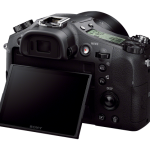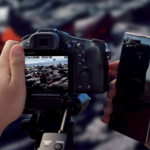
Sony’s 20.3 megapixel DSCRX10/B may be part of their Cybershot line, with an integrated lens and an electronic viewfinder, but it might just make serious photographers consider an all-in-one camera for all that it offers, including a DSLR feel in a semi-compact format.
Review by Ernest Lilley
Price: $1299.99 (a value despite the sticker shock)
Sony’s been doing some interesting things with smaller cameras with bigger sensors, among them the DX10/B, which they’re positioning as a “bridge” camera for people who are used to the feel and performance of a DSLR but want something smaller without leaving their comfort zone. That’s good, because there are a number of things that a good all-in-one camera can do that DSLRs can’t, or at least need a whole collection of special lenses to accomplish, while most smaller cameras lack enough mass to feel steady in your hand, regardless of whether they have image stabilizing or not.
The DSCRX10/B is significantly smaller and lighter than a full DSLR, but not so small that it disappears in your hands. It has a substantial feel to it that I personally find reassuring, and yes, I’m a recovering big DSLR user so it’s very attractive to me.
- The RX10 looks serious from the front, thanks to the constant aperture f2.8 lens.
- Tiltable viewfinders are one of my favorite features. Fortunately, Sony has been adding them across their line.
- 4.7 inches front to back, or maybe a little over 4 is you ignore the eyepiece. Not tiny, but that’s a plus for stability and feel.
- Even with the lens all the way out the RX10 doesn’t look like a point and shoot.
- Wifi and Near Field connectivity are overdue functions on most DSLRs but the RX10 has them.
- The 2.36M dot OLED viewfinder is as good as it gets, and more useful than an optical, though that’s a touch adjustment for some to make.
The Good:
- The Lens — If the lens isn’t good, nothing’s good, but despite its size, the constant aperture f/2.8 Carl Zeiss® Vario-Sonnar T* lens with a full size (35mm) sensor equivalent range of 24-200mm delivers excellent quality. While you can pick up any number of zoom lenses for APS-C sensor DSLRs, none of them are as small and light, very few, if any hold the f setting across the range, and none of them offer the additional macro capability that this lens does. There are reasons why you might still want a prime lens on a camera, but honestly, for nearly all your shooting this lens is going to do the job.
- The body/viewfinders — True, the screen on the back is only 3″, and you can find larger displays on smaller cameras, though rarely on bigger ones, but what we like most about the rear screen is its ability to tilt up or down, something Sony has put on nearly all their cameras. It’s important that the screen stays on the same axis as the lens for ease of composition, and it’s great to be able to look down into it rather than having to crouch down in order to see a low angle shot. Since the screen also tilts down, you can actually use it to compose in bright sunlight by looking up into it as it creates its own shadow. It’s a neat trick and we like the feature. Still, there are times when you really want an eye-level viewfinder, and Sony’s move away from optical to electronic viewfinders, in this case a 2.36M dot OLED viewfinder, which is as about the best of the breed. Sony’s a6000, soon to be released, steps back from the 2.36M for some odd reason (price) and I’ve heard reviewers bemoan the reduction in quality. Still good, they say, but not as good as this. The switch from optical to electronic viewfinder isn’t easy for SLR users, but it’s a good thing, allowing you to see not just what the lens is seeing, but what the camera is actually making of it.
- Sensor and Processor — The 20.2MP 1.0-inch Exmor R® CMOS sensor is big for this class of camera, and it uses that size to enable a large dynamic range, making it unusually good at low light photography for a non full size sensor camera. It also offers enough pixels that you can crop a fair amount without sacrificing image quality, which has the effect of extending the 200mm lens’ magnification by another 25-33%. But the sensor is only half the story when it comes to image quality, unless you’re determined to shoot in RAW (unprocessed image) format, in which case, you should just be shooting with a full-frame (or larger) DSLR and be done with it. Personally, I’ve never gotten into it. The other half comes from the camera’s processor and software, and theRX10 gets a BIONZ® X image processing engine matched to the lens to “with richer tonal gradations and lower image noise than was previously possible.” No, I don’t know how, but the reviewer consensus is that it’s true.
- WiFi Connectivity — There are a number of features that bigger, more expensive cameras haven’t gotten into yet, and one of them is WiFi connectivity to allow you to upload pictures through your smartphone. Pros don’t show unedited images, their reasoning goes, and I get that, but these days we’re all journalists of a sort, and being able to post immediately is a must have function. The RX10 gets it, offering both Wi-Fi® or NFC connectivity.
- Other Good things —The camera is as quiet as you want, with the ability to turn off all it’s operating noises, something an SLR, with its mirror slap can’t do. If you’re into video, so is it, and it has stereo mic inputs and an accessory sound kit to go with it. And it’s moisture and dust resistant, which is an advantage non-interchangeable lenses offer naturally. Though the camera has plenty of functionality built in, by the way, the RX10 has an impressive accessory collection and a full size hot-shoe, so you can load up if your mission needs something extra.
The Bad:
- Price — $1299.99, better known as thirteen hundred bucks, is a lot of money for a point and shoot camera. Or it would be if that was what the RX10 is, but fortunately its not. Still, there are lots of DSLRs you can buy with an equivalent lens (mostly) for less. But if you do, then you’re committed to buying all the other pieces you’ll need to match the range of functions hat the RX 10 offers.
- Size — Again, it’s one of those bug or feature issues depending on what you want. There’s no pocket in the world that you can stuff this camera into, but that’s not what you wanted it for. Still, even with the lens retracted, the camera is 4.7 inches deep, though nearly half an inch of that is the eyepiece, which doesn’t really count. It’s also 12.7oz or 3/4 of a pound, but that’s not heavy compared to a full kit DSLR.
Conclusion:
Sony’s calling this a “bridge” camera, and they’re right, but not quite the way they mean it. They’re hoping that pros will pick it up as a second camera and fall in love with the idea of mirror-less all-in-one cameras. They might. Personally, I’ve been waiting for digital photography to move on from a legacy film format for a long time and I welcome cameras like this, but I have a hard time believing that you can own a full DSLR system and the RX10 and not wind up dragging both around and feeling guilty no matter which one you’re using. I think the real bridge it offers is for people who want more than a camera they can fit in their pocket but don’t want to turn photography into being all about their gear collection.
Links: Product Home Page / Sony Press Release / DPReview’s Review /Amazon





